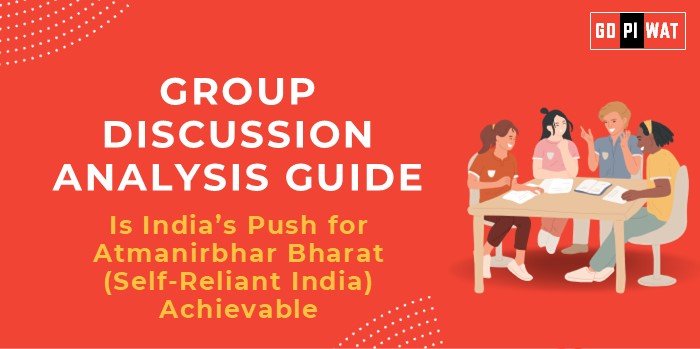📋 Group Discussion Analysis Guide: Is India’s Push for Atmanirbhar Bharat (Self-Reliant India) Achievable?
🌐 Introduction to Atmanirbhar Bharat
Opening Context: Atmanirbhar Bharat, or Self-Reliant India, is a flagship initiative aimed at strengthening domestic industries, reducing import dependency, and enhancing India’s role in the global economy. Launched in 2020 during the COVID-19 pandemic, it symbolizes resilience and ambition.
Topic Background: The initiative targets critical sectors such as manufacturing, healthcare, defense, and technology, with specific policies like the Production Linked Incentive (PLI) scheme driving growth. The vision aligns with India’s goal of achieving sustainable and inclusive development by fostering innovation and self-sufficiency.
📊 Quick Facts and Key Statistics
- 📜 PLI Scheme Budget: ₹1.97 lakh crore allocated across 13 sectors for domestic manufacturing (2024).
- 🌍 FDI Inflows: $70.9 billion (approx. ₹5.8 lakh crore) in FY 2023-24, showcasing sustained global interest in Indian markets.
- 📈 Export Growth: India’s total exports (merchandise and services) reached $776.68 billion in FY 2023-24, with merchandise exports at $437.06 billion.
- 🛡️ Defense Production Goal: Targeting ₹1.75 lakh crore by 2025, with ₹35,000 crore allocated to exports.
🎯 Stakeholders and Their Roles
- 🏛️ Government: Enacts policies like the PLI scheme, promoting ease of doing business and infrastructure investments.
- 💼 Private Sector: Drives R&D, production, and exports; plays a vital role in scaling domestic capacities.
- 👩💻 Citizens: Engage as consumers, entrepreneurs, and skilled workers, adopting indigenous solutions.
- 🌐 Global Investors and Partners: Contribute to technological collaboration, FDI inflows, and international market access.
🏆 Achievements and Challenges
🔑 Achievements
- 📱 PLI Success: The electronics sector, including smartphone manufacturing, saw a 28% increase in output in FY 2023-24.
- 📈 Export Growth: Services and merchandise exports reached a record high of $776.68 billion, showcasing competitiveness in global markets.
- 🌍 FDI Trends: With $70.9 billion in FDI inflows, India remains a preferred investment destination.
- 🛡️ Defense Sector Progress: Defense exports touched ₹16,000 crore in FY 2023-24, moving closer to the ₹35,000 crore target by 2025.
⚠️ Challenges
- 🚧 Infrastructure Bottlenecks: Gaps in logistics and energy availability affect productivity.
- 🎓 Workforce Skilling: Limited industry-ready skills among a large segment of the workforce.
- 🌏 Global Competition: Competing with nations like China and Vietnam in manufacturing and exports.
📖 Case Study: Bengaluru Tech Hub
🏙️ Bengaluru Tech Hub: Benefited from Atmanirbhar Bharat incentives, attracting ₹12,000 crore in R&D investments and creating 25,000 new jobs in FY 2023-24.
🗣️ Structured Arguments for Discussion
- ✅ Supporting Stance: “India’s export growth to $776.68 billion and rising FDI inflows of $70.9 billion underline the feasibility of achieving Atmanirbhar Bharat’s goals.”
- ❌ Opposing Stance: “Dependency on imported technology and infrastructure challenges indicate the vision’s execution hurdles.”
- ⚖️ Balanced Perspective: “While initiatives like the PLI scheme are driving growth, addressing skill gaps and infrastructure deficits is essential for achieving self-reliance.”
💡 Effective Discussion Approaches
🌟 Opening Approaches
- 📊 Statistical Impact: “India’s merchandise exports touched $437.06 billion in FY 2023-24, demonstrating significant progress toward self-reliance.”
- ⚖️ Contrast: “Despite achieving record exports, India still imports 60% of its manufacturing machinery, highlighting gaps in domestic capabilities.”
🎯 Counter-Argument Handling
- 🔄 Rebuttal: “Though India imports critical machinery, investments in R&D and skill training are steadily reducing foreign dependency.”
📊 Strategic Analysis: SWOT
- 💪 Strengths: Export growth, robust FDI inflows, and innovative policies like PLI.
- ❓ Weaknesses: High dependence on imports for key technologies and limited rural industrial participation.
- 🌟 Opportunities: Emerging global supply chain realignment and the integration of green energy solutions.
- ⚠️ Threats: Rising competition from Southeast Asian countries and geopolitical risks.
📚 Connecting with B-School Applications
- 🧠 Real-World Applications: Financial analysis of PLI schemes and their impact on GDP. Operations management insights into export supply chain optimization.
- 📋 Sample Interview Questions:
- 🤔 “How does Atmanirbhar Bharat redefine India’s manufacturing sector?”
- 💼 “Evaluate the role of global collaborations in achieving India’s self-reliance goals.”
- 💡 Insights for B-School Students:
- 📉 Assess public-private partnership models for policy implementation.
- 🌏 Explore supply chain efficiencies to minimize import dependencies.


